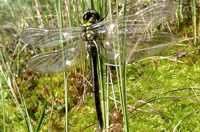Plymouth scientists breathe new life into oxygen theory behind giant dragonfly extinction

Now a study of more diminutive modern day insects may have provided answers to questions that have occupied scientists for over 100 years – why did these giant insects become extinct, and how did they evolve in the first place?
The oxygen-rich atmosphere of the Carboniferous period has long-been suspected to have played a part in this gigantism, and ecologists at Plymouth University have proposed a novel explanation for how oxygen drove gigantism, after investigating the responses of modern-day aquatic insect larvae to 02 levels in water.
In their article, published in Public Library of Science, Dr Wilco Verberk and Dr David Bilton, of the School of Marine Science and Engineering, set out their findings on how the thermal tolerance of aquatic larvae is more sensitive to differences in oxygen than that of terrestrial adults.
Dr Verberk said: “To date, attempts to understand insect gigantism in the past have been mainly approached from the perspective of (fossilized) terrestrial adults.
“Our work suggests that oxygen limitation at thermal extremes operates differently for aquatic larvae and terrestrial adults, and that approaching the problem of historical gigantism from a larval perspective may shed new light on the way in which oxygen sets insect body size limits.”
The study shows that aquatic insect larvae are more sensitive to fluctuations in oxygen levels than terrestrial adults. Aquatic larvae, such as those of dragonflies, stoneflies and mayflies, extract their oxygen directly from the water, where far less is available than in air.
In addition, whereas terrestrial insects can just open their trachea to take up the oxygen they need, that option is not available in water. As a result, oxygen’s role in shaping insect body size may be particularly important in aquatic larvae, setting an upper size limit since larger larvae need to transport oxygen further to get it to their tissues.
Dr Bilton added: “In prehistoric times, higher levels of oxygen may have favoured the evolution of giant insects largely through their effects on larvae, and it is perhaps no accident that many extinct giants had aquatic juvenile stages.”
More information: Can oxygen set thermal limits and drive gigantism? PLoS One 6(7): e22610. doi: 10.1371/journal.pone.0022610
Provided by University of Plymouth


















